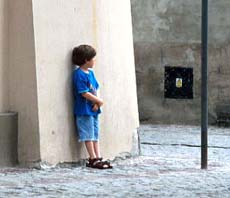index
Modern homelessness / native spaciousness
click on images for full-size:




In the Old Town, Lublin, Poland

Warrenton, Virginia

In the Old Town, Lublin, Poland
Links and connections always reach beyond the current place or unity. Meaning and presence require connections to absent possibilities.How then do we get from meanings requiring connections to the idea of a native spaciousness to our inhabitation of places?
By stressing the temporality of our existence.
How then do we see that places can't be totally homey?by seeing that self-aware temporality can't ever settle down.
We can never be fully and securely at home because contrasts and links are always needed, and so the more self-aware we are of being at home in this place, the more it stands in contrast and relations, and thus does not completely enclose us. Even exclusion and negation are relations that keep the other present as rejected.How does this native spaciousness relate to the modern sense of homelessness?They are not the same, nor is modern homelessness an accentuated version of the native spaciousness. Modern homelessness is one empirical attitude that is made possible by the general spaciousness, and should itself be lived in a spacious way.
(In Heideggerese: Modern homelessness is a metaphysical ontic version of an ontological spaciousness, and should be lived authentically, which means we are not totally defined by that ontic attitude, which can, however, serve as an opening into that fuller field that it does not fully define.)